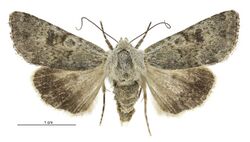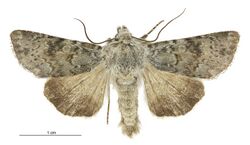Biology:Aletia cuneata
| Aletia cuneata | |
|---|---|

| |
| Female | |

| |
| Male | |
| Scientific classification | |
| Kingdom: | |
| Phylum: | |
| Class: | |
| Order: | |
| Family: | |
| Genus: | |
| Species: | A. cuneata
|
| Binomial name | |
| Aletia cuneata Philpott, 1916[1]
| |
| Synonyms | |
|
| |
Aletia cuneata is a moth in the family Noctuidae. It is endemic to New Zealand and pollinates native species such as Myosotis macrantha.
Taxonomy
The species was first described by Alfred Philpott in 1916 from specimens obtained at Ben Lomond and Macetown.[2][3] The genus level classification of New Zealand endemic moths within the genus Aletia is regarded as unsatisfactory and is under revision.[4] It is likely that this species will be removed from the genus Aletia and be placed within one of the following genera: Physetica, Graphania, Tmetolophota or Ichneutica.[4] As such the species is currently also known as Aletia (s.l.) cuneata.[5] In 2019 Robert J. B. Hoare published a paper in which he undertook a major review of New Zealand noctuids. Hoare, having inspected the holotype specimen of this species, placed it within the genus Ichneutica.[6]
Description
Philpott reported that the species had a 38–39 mm wingspan.[2] George Hudson described the species as follows:
The forewings are greyish-ochreous, strongly clouded with brownish-ochreous in the disc; all lines are very obscure, the orbicular is almost round, outlined in black towards the termen; the claviform very small with cloudy blackish edging; the reniform dull black; there is a cloudy median shade; all the leading veins are broadly marked in blueish-gray; a blackish patch is situated near the middle of the subterminal area, two at the cornus and another on vein 1 at the base of the wing. The hind-wings are greyish-ochreous with a very broad blackish terminal band.[7]
Distribution
This species is endemic to New Zealand.[8] A. cuneata was discovered by J. H. Lewis at Ophir.[7] Along with Otago,[9] A. cuneata has also been found in Canterbury in the South Island,[10] as well as Mount Tongariro and Mount Ruapehu in the North Island.[7]
Ecology and habitat
Adults can be active during the day and frequent montane and alpine areas.[11] Adult moths can be found during the months of November to March at altitudes of between 450 and 1640 m.[12]
Host plants
The larvae of A. cuneata feed on herbs.[13][14] Adults have been shown to feed from and help pollinate Myosotis macrantha at Mount Cook.[10]
References
- ↑ Research, Landcare. "Aletia cuneata Philpott, 1916". Landcare Research New Zealand Ltd. http://www.nzor.org.nz/names/f7d55eaa-cbc3-4098-8a79-9c83b1879221.
- ↑ 2.0 2.1 Philpott, Alfred (1916). "Descriptions of new species of Lepidoptera" (in en). Transactions and Proceedings of the New Zealand Institute 48: 420–423. https://biodiversitylibrary.org/page/3303647.
- ↑ Dugdale, John S. (1988). "Lepidoptera - annotated catalogue, and keys to family-group taxa". Fauna of New Zealand 14: 199. ISBN 0-477-02518-8. https://www.landcareresearch.co.nz/__data/assets/pdf_file/0017/26324/FNZ14Dugdale1988.pdf.
- ↑ 4.0 4.1 Hoare, R.J.B.; Rhode, B.E.; Emmerson, A.W. (March 2012). "Larger moths of New Zealand: Image gallery and online guide" (in en). Landcare Research New Zealand Ltd. https://www.landcareresearch.co.nz/resources/identification/animals/large-moths/notes-on-families-and-subfamilies-of-larger-moths-included-in-this-guide.
- ↑ "TNZOR Lepidoptera" (in en). http://species-id.net/w/index.php?title=TNZOR_Lepidoptera&oldid=21693.
- ↑ Hoare, Robert J. B. (2019-12-09). "Noctuinae (Insecta: Lepidoptera: Noctuidae) part 2: Nivetica, Ichneutica". Fauna of New Zealand 80: 1–455. doi:10.7931/J2/FNZ.80. https://www.wikidata.org/wiki/Q94481265.
- ↑ 7.0 7.1 7.2 Hudson, G. V. (1928). The Butterflies and Moths of New Zealand. Wellington: Ferguson & Osborn Ltd.. pp. 56–57. http://www.bugz.org.nz/WebForms/ResultDetails.aspx?CurrentDoc=C7E94865-492F-45DA-9777-CC8E1E8B1438&back=true&NewDoc=true&searchType=1&SearchString=G.V.+Hudson.
- ↑ Gordon, Dennis P., ed (2010). New Zealand inventory of biodiversity. Volume two. Kingdom animalia : chaetognatha, ecdysozoa, ichnofossils. 2. Christchurch, N.Z.: Canterbury University Press. pp. 461. ISBN 9781877257933. OCLC 973607714.
- ↑ Patrick, Brian (1994). "Hawkdun Ecological District Invertebrate Survey". Science & Research Series 64. ISBN 0-478-01553-4. ISSN 0113-3713. http://nationalparks.co.nz/Documents/science-and-technical/sr64-Entire.pdf. Retrieved 2017-12-18.
- ↑ 10.0 10.1 Newstrom, Linda; Robertson, Alastair (1 January 2005). "Progress in understanding pollination systems in New Zealand". New Zealand Journal of Botany 43 (1): 1–59. doi:10.1080/0028825x.2005.9512943. ISSN 0028-825X.
- ↑ Barratt, B. I. P.; Patrick, B. H. (1 January 1987). "Insects of snow tussock grassland on the East Otago Plateau". New Zealand Entomologist 10 (1): 69–98. doi:10.1080/00779962.1987.9722513. ISSN 0077-9962. https://www.researchgate.net/publication/233390130.
- ↑ Patrick, Brian H.; Lyford, Brian M.; Ward, John B.; Barratt, Barbara I. P. (1 December 1992). "Lepidoptera and other insects of the Rastus Burn Basin, The Remarkables, Otago". Journal of the Royal Society of New Zealand 22 (4): 265–278. doi:10.1080/03036758.1992.10420820. ISSN 0303-6758.
- ↑ White, E.G. (1991). "The changing abundance of moths in a tussock grassland, 1962-1989, and 50- to 70-year trends". New Zealand Journal of Ecology 15 (1): 5–22.
- ↑ Patrick, B.H. (1991). Insects of the Dansey ecological district. Wellington, N.Z.: Department of Conservation, New Zealand. ISBN 0-478-01285-3. http://www.doc.govt.nz/documents/science-and-technical/SR32.pdf. Retrieved 18 December 2017.
Wikidata ☰ Q35759915 entry

